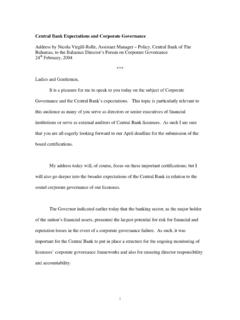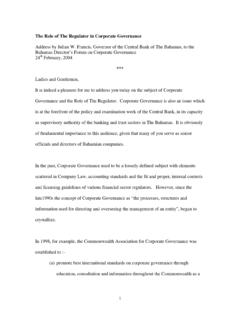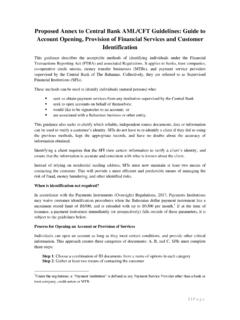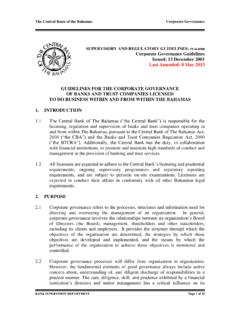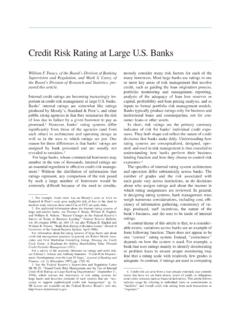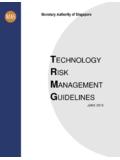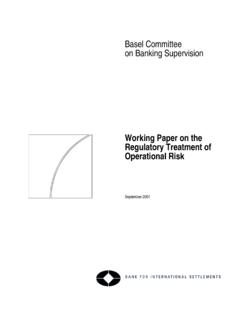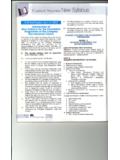Transcription of GUIDELINES FOR THE MANAGEMENT OF LIQUIDITY …
1 The Central Bank of The Bahamas Minimum LIQUIDITY Requirements BANK SUPERVISION DEPARTMENT Page 1 of 19 SUPERVISORY AND REGULATORY GUIDELINES : PU68-0510 MANAGEMENT of LIQUIDITY Risk Issued: 25th March 2005 Revised: 20th April 2012 GUIDELINES FOR THE MANAGEMENT OF LIQUIDITY RISK 1. INTRODUCTION The Central Bank of The Bahamas ( the Central Bank ) is responsible for the licensing, regulation and supervision of banks and trust companies operating in and from within The Bahamas, pursuant the Central Bank of The Bahamas Act, 2000 ( the CBA ) and the Banks and Trust Companies Regulation Act, 2000 ( the BCTRA ). Additionally, the Central Bank has the duty, in collaboration with financial institutions, to promote and maintain high standards of conduct and MANAGEMENT in the provision of banking and trust services.
2 All licensees are expected to adhere to the Central Bank s licensing and prudential requirements, ongoing supervisory programmes and regulatory reporting requirements, and are subject to periodic on-site examinations. Licensees are expected to conduct their affairs in conformity with all other Bahamian legal requirements. 2. PURPOSE LIQUIDITY is a licensee s capacity to fund increases in assets or meet collateral obligations at a reasonable cost as they fall due, without incurring unacceptable losses. Maintaining an adequate level of LIQUIDITY depends on the licensee's ability to meet both expected and unexpected cash flows efficiently and collateral needs, without adversely affecting either daily operations or the financial condition of the licensee.
3 LIQUIDITY risk is the risk that a licensee s financial condition or overall safety and soundness is adversely affected by an inability real or perceived to meet its contractual obligations. A licensee's obligations and the funding sources used to meet them depend significantly on its business mix, balance sheet structure, and the cash-flow profiles of its on- and off-balance sheet obligations. In managing their cash flows, licensees confront various situations that can give rise to increased LIQUIDITY risk. These include funding mismatches, market constraints on the ability to convert assets into cash or in accessing sources of funds ( , market LIQUIDITY ), and contingent LIQUIDITY events.
4 Changes in economic conditions or exposure to credit, market, The Central Bank of The Bahamas Minimum LIQUIDITY Requirements BANK SUPERVISION DEPARTMENT Page 2 of 19 operation, legal, and reputation risks also can affect a licensee's LIQUIDITY risk profile. Lessons learned from the recent events in financial markets have pointed to the importance of LIQUIDITY and the need for improvement in LIQUIDITY risk MANAGEMENT in financial institutions. To account for financial market developments, as well as the lessons learned from the recent financial market turmoil, the Central Bank undertook a fundamental review of the 2005 GUIDELINES for the MANAGEMENT of LIQUIDITY Risk to bring them in conformance, where appropriate, with the Principles for Sound LIQUIDITY Risk MANAGEMENT and Supervision issued by the Basel Committee on Banking Supervision in September 2008.
5 These revised GUIDELINES , therefore, provide guidance to licensees in relation to the Central Bank s expectations of their LIQUIDITY risk MANAGEMENT practices, as well as outlining the Central Bank s approach to assessing the adequacy of licensees LIQUIDITY risk MANAGEMENT frameworks and their LIQUIDITY positions. 3. APPLICABILITY These GUIDELINES apply to all public banks and/or trust companies. However, pursuant to Regulation 6(2) of the Banks and Trust Companies ( LIQUIDITY Risk MANAGEMENT ) Regulations 2011 ( the LRMR ), the LIQUIDITY ratio shall not currently apply to licensees that are subject to the provisions of section 19 and 20 of the CBA ( commercial banks ).
6 The Central Bank recognises that the degree of sophistication of a licensee s LIQUIDITY risk MANAGEMENT framework will depend on the nature, scale of complexity of a licensee s activities, as well as the level of LIQUIDITY risk assumed. The Central Bank equally accepts that in the supervision of internationally active banks, account should also be taken of the global LIQUIDITY risk MANAGEMENT frameworks of the head office and the home supervisor s assessment of the overall LIQUIDITY risk MANAGEMENT framework and LIQUIDITY positions. 4. DEFINITIONS Liquid assets have the same meaning as defined by Regulation 2 of the LRMR.
7 LIQUIDITY ratio means the ratio of the sum of a licensee s liquid assets (in all currencies) expressed as a percentage of the sum of its deposit liabilities (in all currencies). 5. SOUND PRACTICES OF LIQUIDITY RISK MANAGEMENT The Central Bank of The Bahamas Minimum LIQUIDITY Requirements BANK SUPERVISION DEPARTMENT Page 3 of 19 Because of its critical importance to the viability of a licensee, LIQUIDITY risk MANAGEMENT should be fully integrated into the licensee's risk MANAGEMENT processes. Therefore, licensees should have a comprehensive MANAGEMENT process for identifying, measuring, monitoring and controlling LIQUIDITY risk, appropriate to the operations of the licensee.
8 Critical elements of sound LIQUIDITY risk MANAGEMENT are highlighted below: i. Effective corporate governance consisting of oversight by the board of directors and active involvement by senior MANAGEMENT in an institution's control of LIQUIDITY risk; ii. Appropriate strategies, policies, procedures, and limits used to manage and mitigate LIQUIDITY risk; iii. Comprehensive LIQUIDITY risk measurement and monitoring systems (including assessments of the current and prospective cash flows or sources and uses of funds) that are commensurate with the complexity and business activities of the institution; iv. Active MANAGEMENT of intraday LIQUIDITY and collateral; v.
9 An appropriately diverse mix of existing and potential future funding sources; vi. Adequate levels of highly liquid marketable securities free of legal, regulatory, or operational impediments that can be used to meet LIQUIDITY needs in stressful situations; vii. Internal controls and internal audit processes sufficient to determine the adequacy of the institution's LIQUIDITY risk MANAGEMENT process; and viii. Appropriate contingency funding plans ( CFPs ) that sufficiently address potential adverse LIQUIDITY events to which the institution may be exposed and emergency cash flow requirements.
10 The Central Bank will review these critical elements in its assessment of a licensee s LIQUIDITY risk MANAGEMENT framework, during the course of its on-site examination of licensees and the risk assessment process, generally. 6. LIQUIDITY RISK MANAGEMENT FRAMEWORK Board and Senior MANAGEMENT Responsibilities Ultimate responsibility for the LIQUIDITY risk assumed by a licensee and the manner in which this risk is managed rest with the licensee s Board of Directors ( the Board ). For branches of international banks, the responsibilities set forth in these GUIDELINES for the Board should be assumed by the head office of the local branch.


